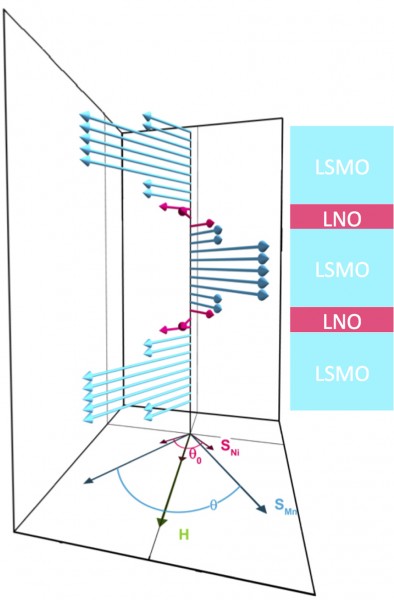

| Online: | |
| Visits: | |
| Stories: |

| Story Views | |
| Now: | |
| Last Hour: | |
| Last 24 Hours: | |
| Total: | |
Scientists Discover Magnetic “Persuasion” In Neighboring Metals
A diagram showing the “spiral” of noncollinear magnetic orientations (in pink) of a nickelate material next to a manganite material.

Credit: Anand Bhattacharya/Argonne National Laboratory
The researchers found that as electrons flowed out of the manganite into the neighboring nickelate, the non-magnetic nickelate suddenly became magnetic – but not in a typical way. While most magnetic materials are “collinear”, meaning that the magnetic orientations of the electrons in the materials are arranged either in the same or opposite directions – that is, what we think of as “north” or “south” – this was not the case for the affected nickelate. As the electrons flowed into the nickelate, it created a magnetization with a twisting pattern as in a helix.Although it is nonmagnetic on its own, the nickelate has certain proclivities that make it a good candidate for being “willing to be swayed,” Bhattacharya said.
“The measure that scientists use to quantify how much a material wants to be magnetic is called ‘magnetic susceptibility,” Bhattacharya explained. “The nickelate has a very peculiar magnetic susceptibility, which varies from atom to atom within the material. Under the influence of the neighboring manganite, the nickelate becomes magnetic in a surprising way, causing a non-uniform helical magnetic structure to develop in the nickelate.”
According to Bhattacharya, magnetic noncollinearity is difficult to tailor in the laboratory. “This noncollinear twisty magnetism is shown by only a very few types of materials and is quite rare in nature,” said Bhattacharya. “It’s an exciting property to have in a material because you could conceivably use the different magnetic orientations to encode data in a novel kind of magnetic memory, or to nucleate new kinds of superconducting states that might be useful in a quantum computer.”
An article based on the research, “Oscillatory Noncollinear Magnetism Induced by Interfacial Charge Transfer in Superlattices Composed of Metallic Oxides,” appeared in Physical Review X in November. The Argonne research was funded by DOE’s Office of Science. Additional components of the research were performed at the National Institutes of Standards and Technology.
Contacts and sources:
Jared Sagoff
Source: http://www.ineffableisland.com/2017/03/scientists-discover-magnetic-persuasion.html


